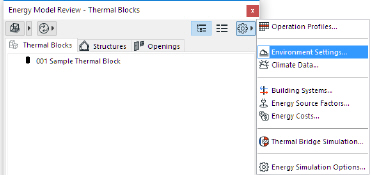
Energy Evaluation Workflow: Overview
This section summarizes the steps of the Energy Environmental Workflow.
Prepare the Architectural BIM for Energy Evaluation
For successful evaluation, the building model must contain at least the enveloping structures and fenestration, as well as all major internal structures that represent significant heat storage mass.
Furthermore, ARCHICAD zones must be placed in every conditioned space of the building, since the model’s geometry analysis is based on these ARCHICAD zones.
The Energy Model Review works only on visible elements, so you must define an ARCHICAD view dedicated to the energy model. Use layer visibility to achieve the view you need. Make sure that zones are visible.
Note: Marquee selection does not filter building elements for the purpose of Energy Model Review.
Spaces are represented by 3D Zones in the ARCHICAD Building Energy Model. For Energy Evaluation purposes, you will group these Zones together in “thermal blocks”, using the Thermal Blocks page of the Energy Model Review palette (Design > Energy Evaluation > Energy Model Review).
Thermal blocks are a collection of one or more rooms or spaces in a building that have similar orientation, operation profile and internal temperature requirements (also called thermostat control requirements). Zones need not be contiguous to be combined within a single thermal block.
Automatic Model Geometry and Material Property Analysis
After the thermal blocks have been defined, the architectural model (BIM) is transformed into a Building Energy Model (BEM) by the automatic model geometry and material property analysis functionality of ARCHICAD. This analysis does the following:
•analyzes the visible structures and openings according to their orientations and positions relative to zones and generates the space boundaries on them. (Space boundaries describe the building’s geometry in a format that works for energy simulation input.)
•populates the space boundary lists. Structures and Openings are automatically listed with their properties that are relevant for the energy evaluation.
Assign and Input Additional Data to Complete the BEM
The Energy Model Review palette is the main user interface of ARCHICAD’s Energy Evaluation function. Use the palette to edit the input data for the building energy simulation, as well as to add information:
•Assign Building Systems and Operation Profiles to Thermal Blocks
•Space boundary property settings
Note: Most space boundary properties are extracted from the architectural model by the automatic model geometry and material property analysis functionality of ARCHICAD. Space boundary property settings allow users to fine-tune this data and add information that does not come directly from the architectural building model.
•Structures property settings: Use the U-value calculator or U-value override functionality and the Infiltration and Surface material settings to define the physical properties of the opaque space boundaries listed on the Structures list.
–Openings property settings: Assign Frame and Glazing performance data to fenestration from the Openings catalog. Select Shading devices from predefined databases to complete the Openings list.
Besides displaying the Structures and Openings list, the user-friendly Energy Model Review palette also contains links to dialogs.

These Additional Data Input dialogs enable quick definition of the following parameters needed to run the Energy Evaluation:
•Environment Settings: Provides links to the Project Location, Climate Data and Wind Protection dialogs. Grade level, Soil and Surrounding surface types are also set here.
•Operation Profile: Select the building’s function(s) to assign related Internal temperature and heat gain profiles in the Operation Profile dialog. If needed, customize an Operation Profile to fine-tune occupancy according to local regulations or to match actual building usage.
•Building Systems: Provide information essential for the energy calculation, regarding the building’s MEP Systems (for heating, cooling, ventilation, hot water generation)
•Finally, in order to enable primary energy, CO2 emission and energy cost calculations, define the Energy Source Factors and Energy Costs, using the dedicated dialogs.
Evaluate Building Energy Performance
Click the Start Energy Simulation button of the Model Review palette to start the Energy Performance Evaluation of your project. The built-in, certified VIP-Core engine executes the dynamic energy simulation that calculates the building’s hourly energy balance and outputs a Building Energy Evaluation Report. The report contains information such as the project’s energy-related structural performance, yearly energy consumption, energy balance and carbon footprint.